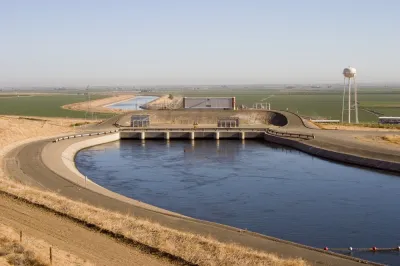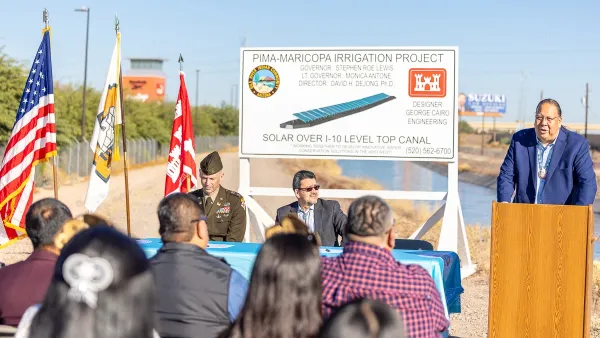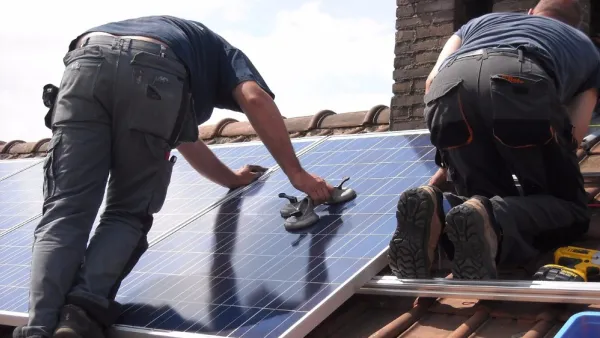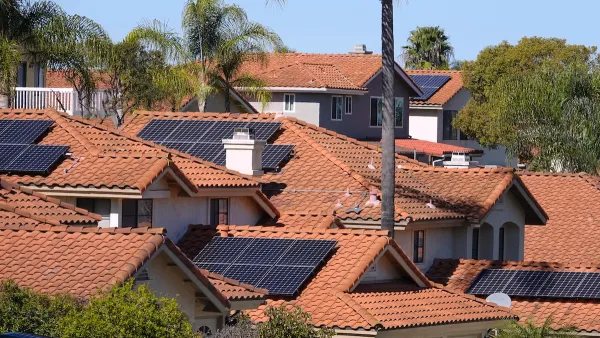Research claims that installing solar panels over California's extensive canals could greatly expand the state's renewable energy production and reduce evaporation.

A new study published in Nature Sustainability outlines the potential benefits of covering California's canals with solar panels, reports Matt Simon in High Country News. The study's results show that installing solar panels over 4,000 miles of California's waterways "would save 63 billion gallons of water from evaporating each year" and "provide 13 gigawatts of renewable power annually, about half of the new capacity the state needs to meet its decarbonization goals by the year 2030."
Doubling up on uses for the canals would provide a convenient solution for solar installations that would otherwise require the disturbance of natural habitats or farmland. Michael Kiparsky, director of the Wheeler Water Institute at the UC Berkeley School of Law, likens the idea to placing rooftop solar panels on a suburban home. "You’re taking something that's already been altered by human activity and doubling up on the benefits it provides."
Environmental engineer Brandi McKuin, lead author on the paper, said that "by covering canals with solar panels, we can reduce evaporation and avoid disturbing natural and working lands, while providing renewable energy and other co-benefits." The study's authors "also took into account the human benefits of such a project, which are more nebulous. For example, many farmers pump their water with diesel generators. If solar panels provided that energy instead, that could cut local emissions, thus improving air quality."
"Solar-paneling California’s canals could also prepare the state for the widespread adoption of electric cars. The California Aqueduct runs right along Interstate 5, the major artery carrying traffic between the northern and southern halves of the state. Where there are now gas stations dotted along the way, in the future there might be car-charging stations that draw power from the nearby aqueduct."
The study's authors recommend a demonstration project to evaluate the costs, benefits, and potential challenges associated with a full-scale implementation of the concept.
FULL STORY: Study looks at covering California’s canals with solar panels

National Parks Layoffs Will Cause Communities to Lose Billions
Thousands of essential park workers were laid off this week, just before the busy spring break season.

Retro-silient?: America’s First “Eco-burb,” The Woodlands Turns 50
A master-planned community north of Houston offers lessons on green infrastructure and resilient design, but falls short of its founder’s lofty affordability and walkability goals.

Delivering for America Plan Will Downgrade Mail Service in at Least 49.5 Percent of Zip Codes
Republican and Democrat lawmakers criticize the plan for its disproportionate negative impact on rural communities.

Test News Post 1
This is a summary

Test News Headline 46
Test for the image on the front page.

Balancing Bombs and Butterflies: How the National Guard Protects a Rare Species
The National Guard at Fort Indiantown Gap uses GIS technology and land management strategies to balance military training with conservation efforts, ensuring the survival of the rare eastern regal fritillary butterfly.
Urban Design for Planners 1: Software Tools
This six-course series explores essential urban design concepts using open source software and equips planners with the tools they need to participate fully in the urban design process.
Planning for Universal Design
Learn the tools for implementing Universal Design in planning regulations.
EMC Planning Group, Inc.
Planetizen
Planetizen
Mpact (formerly Rail~Volution)
Great Falls Development Authority, Inc.
HUDs Office of Policy Development and Research
NYU Wagner Graduate School of Public Service





























